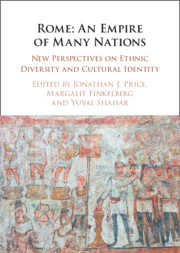Book contents
- Rome: An Empire of Many Nations
- Reviews
- Rome: An Empire of Many Nations
- Copyright page
- Contents
- Figures
- Contributors
- Acknowledgments
- Abbreviations
- Introduction
- Part I Ethnicity and Identity in the Roman Empire
- Part II Culture and Identity in the Roman Empire
- Part III Ethnicity and Identity in the Roman Empire
- Part IV Iudaea/Palaestina
- Bibliography
- General Index
- Index Locorum
Introduction
- Rome: An Empire of Many Nations
- Reviews
- Rome: An Empire of Many Nations
- Copyright page
- Contents
- Figures
- Contributors
- Acknowledgments
- Abbreviations
- Introduction
- Part I Ethnicity and Identity in the Roman Empire
- Part II Culture and Identity in the Roman Empire
- Part III Ethnicity and Identity in the Roman Empire
- Part IV Iudaea/Palaestina
- Bibliography
- General Index
- Index Locorum
Summary
When Greek historians turned their attention to the Roman Empire, the main question they sought to answer, which they displayed prominently in their introductions, was the reason for the success of the Empire. Success was defined in terms of acquisition, extent, stability and duration of conquest. Polybius, although not the first Greek historian of Rome, was perhaps the first to formulate the question, which he stated like a banner in the introduction to his complex work: his purpose was to explain ‘by what means and under what system of government the Romans succeeded in less than fifty-three years in bringing under their rule almost the whole of the inhabited world, an achievement which is without parallel in human history’. A century later, Dionysius of Halicarnassus did Polybius one better by adding duration of rule to Rome’s achievement: ‘the supremacy of the Romans has far surpassed all those that are recorded from earlier times, not only in the extent of its dominion and in the splendor of its achievements – which no account has as yet worthily celebrated – but also in the length of time during which it has endured down to our day’; and his long preface is filled with other such proclamations. In the second century CE, Appian of Alexandria wrote the same idea in less florid prose: ‘No ruling power up to the present time ever achieved such size and duration’, after stating which he embarked on a long proof. These three historians are representative of a prevailing trend.
- Type
- Chapter
- Information
- Rome: An Empire of Many NationsNew Perspectives on Ethnic Diversity and Cultural Identity, pp. 1 - 14Publisher: Cambridge University PressPrint publication year: 2021



